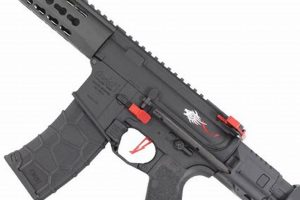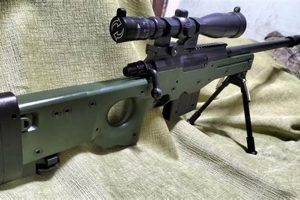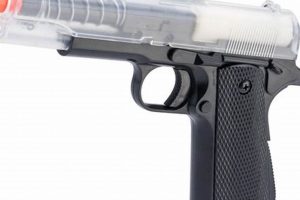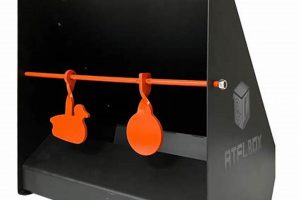These devices represent a segment of recreational weaponry, utilizing battery power to propel projectiles. Specifically, they discharge small plastic pellets, generally 6mm in diameter, through the compression and release of air by an internal electric motor and gearbox mechanism. Operation relies on rechargeable batteries, providing a consistent power source compared to other types of airsoft guns.
The appeal stems from their ease of use, requiring minimal cocking effort compared to spring-powered alternatives. Further, their relatively consistent rate of fire and reduced user fatigue make them suitable for extended skirmishes. Development has progressed from basic models to advanced replicas, enhancing the realism and tactical applications for enthusiasts.
The following sections will delve into aspects such as the internal mechanisms, battery types, performance characteristics, maintenance considerations, and comparative advantages within the broader airsoft market.
Operation and Maintenance Tips
Optimal performance and longevity of these devices are contingent upon adherence to certain maintenance and operational best practices. Consistent application of these tips will mitigate common issues and maximize usability.
Tip 1: Battery Maintenance: Employ only batteries of the recommended voltage and amperage. Overcharging or discharging beyond safe limits can significantly reduce battery life and potentially damage the internal electronics. Implement a consistent charging schedule based on usage frequency.
Tip 2: Gearbox Lubrication: Periodically apply silicone-based lubricant to the internal gearbox components. This reduces friction, prolongs the lifespan of gears, and maintains consistent firing performance. Refer to the manufacturer’s instructions for specific lubrication points and recommended lubricants.
Tip 3: Barrel Cleaning: Regularly clean the inner barrel using a cleaning rod and silicone oil. Accumulated dirt and debris can impede projectile velocity and accuracy. Ensure the power source is disconnected prior to barrel cleaning.
Tip 4: Storage Protocol: When not in use, store the device in a dry, cool environment away from direct sunlight. Remove the battery prior to storage to prevent potential corrosion or damage from battery leakage.
Tip 5: Motor Brush Inspection: Monitor motor brush wear, particularly in models with exposed motors. Replace worn brushes promptly to prevent motor failure. This ensures consistent motor torque and firing rate.
Tip 6: Avoid Dry Firing: Minimize dry firing (firing without a projectile). Repeated dry firing can stress the internal mechanisms and potentially lead to damage, especially to the piston head and nozzle.
Tip 7: Fuse Protection: Familiarize oneself with the location and rating of the internal fuse. A blown fuse typically indicates an electrical overload. Replace the fuse with one of the same rating to prevent further damage to the circuitry.
Consistent application of these measures ensures reliable operation, minimizes the risk of malfunctions, and extends the service life of the equipment. Adherence to the manufacturer’s recommendations remains paramount for safe and efficient use.
The succeeding sections will address troubleshooting common malfunctions and provide guidance on upgrades and modifications to further enhance performance.
1. Battery Voltage
Battery voltage is a critical parameter governing the performance characteristics of electric airsoft pistols. It directly influences the rotational speed of the motor, subsequently dictating the rate of fire and the force with which the piston compresses air to propel the projectile. A higher voltage typically results in an increased rate of fire and potentially higher projectile velocity, though this also increases stress on the internal components. A common example is the difference between a 7.4V and an 11.1V lithium polymer (LiPo) battery; the latter delivers a significantly higher rate of fire but necessitates robust internal components to withstand the increased mechanical stress.
The selection of an appropriate battery voltage must consider the pistol’s design limitations. Exceeding the recommended voltage can lead to premature wear or even catastrophic failure of the gearbox, motor, or wiring. Conversely, using a battery with insufficient voltage may result in sluggish performance and reduced range. Manufacturers generally specify a voltage range that provides an optimal balance between performance and component longevity. Ignoring these specifications can compromise the device’s functionality and safety. For example, installing a high voltage battery into an entry level device that is not meant to handle it. It’s important to consider the C rating and mah rating to prevent damages.
In summary, understanding the relationship between battery voltage and its impact on the device’s operation is essential for maintaining the performance and extending the lifespan. Matching the battery voltage to the pistol’s design parameters, along with adhering to proper charging and maintenance practices, is imperative for safe and reliable operation. Mismatched voltage will negatively affect the performance. Choosing the right mah and C rating will affect the voltage, this could damage the device.
2. Gearbox Durability
Gearbox durability is a paramount consideration in electric airsoft pistols, directly influencing the device’s operational lifespan and performance consistency. As the central mechanical component responsible for converting electrical energy into the pneumatic force that propels projectiles, the gearbox is subjected to considerable stress during operation.
- Material Composition
The materials used in the gearbox construction significantly impact its durability. Zinc alloy, while common in entry-level models, exhibits lower tensile strength and wear resistance compared to steel or reinforced polymers. Upgrading to a gearbox shell constructed from higher-strength materials is a common modification to enhance reliability, particularly in pistols intended for high-stress scenarios, such as sustained rapid firing or use with high-voltage batteries. Failure due to material fatigue is a common issue in lower-quality gearboxes.
- Gear Quality and Design
The gears within the gearbox are subjected to repeated stress cycles. The quality of the gear material (typically steel or hardened alloys) and the precision of their machining directly correlate with their resistance to wear and breakage. Gears with reinforced teeth and optimized tooth profiles distribute stress more evenly, reducing the likelihood of failure. Inferior gears are prone to stripping or cracking under load, rendering the device inoperable.
- Bushings/Bearings
The bushings or bearings supporting the gears within the gearbox minimize friction and ensure smooth rotation. Bushings, typically made of brass or steel, provide a simple and durable support system. Bearings, on the other hand, offer reduced friction and improved efficiency, but may be more susceptible to damage from impact or misalignment. Selecting appropriate bushings or bearings based on the intended operating conditions and power levels is crucial for long-term gearbox health.
- Piston and Piston Head Integrity
The piston, driven by the gears, compresses air to propel the projectile. The piston’s material (typically polymer or reinforced plastic) and the integrity of the piston head seal are critical for maintaining consistent air compression. A cracked piston or a leaking piston head results in reduced power and inconsistent firing. Reinforced pistons with metal teeth are often used in high-stress applications to improve durability and prevent stripping. Using a double o-ring will create a perfect air compression to the device.
In conclusion, gearbox durability is not a singular attribute but rather a composite characteristic determined by the interplay of material quality, component design, and operational stress. Addressing these factors through careful selection of components and adherence to proper maintenance practices is essential for maximizing the lifespan and performance of electric airsoft pistols. The quality of the device plays a vital role in this matter.
3. Motor Efficiency
Motor efficiency, the ratio of mechanical power output to electrical power input, significantly impacts the performance characteristics of electric airsoft pistols. Higher efficiency translates to extended battery life, reduced heat generation, and potentially increased torque and rate of fire, while lower efficiency manifests as diminished performance and increased operational costs.
- Electrical Resistance
The electrical resistance within the motor windings is a primary factor affecting efficiency. Higher resistance leads to increased energy dissipation as heat, reducing the power available for mechanical work. Motors utilizing lower-resistance windings, often achieved through the use of higher-quality copper or improved winding techniques, exhibit superior efficiency and generate less waste heat. A reduction in resistance will often give a good efficient motor.
- Magnetic Field Strength
The strength of the magnetic field generated by the motor’s armature and magnets directly influences the torque output. Stronger magnetic fields enable the motor to overcome greater mechanical resistance within the gearbox, resulting in improved performance, particularly under load. Motors employing neodymium magnets, known for their high magnetic flux density, generally exhibit higher efficiency compared to those using ferrite magnets. Different magnets impact the outcome.
- Brush Design and Contact
The design and material composition of the motor brushes, along with the quality of their contact with the commutator, affect both efficiency and lifespan. Brushes made from high-conductivity materials, such as silver-impregnated carbon, minimize electrical resistance and reduce friction, leading to improved performance and extended brush life. Proper brush seating and consistent contact are crucial for maintaining optimal efficiency. Ensuring the right brush will impact the motor efficiency.
- Gearbox Compatibility
The compatibility between the motor and the gearbox is important to maintain power. A motor with a high torque but the gearbox cannot handle the power or speed. The end result is a inefficient functionality of the airsoft gun.
Optimizing motor efficiency is critical for maximizing the overall performance and usability of electric airsoft pistols. Selecting models equipped with high-efficiency motors, coupled with proper maintenance practices aimed at minimizing friction and electrical resistance, contributes to extended battery life, improved reliability, and a more enjoyable user experience. The level of efficiency plays a huge role.
4. Hop-Up Adjustment
Hop-up adjustment is a critical mechanism influencing the trajectory and range in electric airsoft pistols. This system imparts backspin to the projectile as it exits the barrel, leveraging the Magnus effect to counteract gravity and extend the effective range of the shot. Effective hop-up adjustment is essential for accuracy and maximizing the capabilities of these devices.
- The Magnus Effect and Projectile Trajectory
The Magnus effect, a fundamental principle in ballistics, dictates that a spinning object moving through the air experiences a force perpendicular to both the direction of motion and the axis of rotation. In electric airsoft pistols, the hop-up unit imparts backspin to the BB, creating a pressure differential that lifts the projectile. The degree of backspin, and thus the lifting force, is directly controlled by the hop-up adjustment mechanism. Incorrect adjustment results in either over-hopping, where the projectile climbs excessively and loses range, or under-hopping, where the projectile falls short of the target. Finding the correct adjustment is very important.
- Hop-Up Unit Components and Functionality
A typical hop-up unit consists of a rubber bucking, an adjustment arm, and a pressure point (often a nub or mound). The bucking interfaces with the BB as it passes through the barrel, imparting the desired backspin. The adjustment arm controls the pressure exerted by the nub on the bucking, thereby regulating the amount of backspin imparted to the projectile. Adjusting the arm increases or decreases the pressure, allowing the user to fine-tune the trajectory. The components must be maintained to achieve optimal efficiency.
- Types of Hop-Up Adjustment Mechanisms
Electric airsoft pistols employ various hop-up adjustment mechanisms, ranging from simple rotary dials to more complex sliding levers or click-adjustable systems. Rotary dials offer incremental adjustments, while sliding levers provide a more continuous range of adjustment. Click-adjustable systems offer tactile feedback, allowing for precise and repeatable settings. The choice of adjustment mechanism often depends on the price point and intended use of the pistol, but the underlying principle remains the same: to regulate the backspin imparted to the projectile. The different types provide different outcomes.
- Impact on Effective Range and Accuracy
Proper hop-up adjustment is paramount for maximizing the effective range and accuracy of electric airsoft pistols. With correct adjustment, the projectile follows a flatter trajectory, increasing the probability of hitting the intended target at longer distances. Conversely, improper adjustment leads to inconsistent trajectories and reduced accuracy. Fine-tuning the hop-up setting to match the weight of the BB and the prevailing wind conditions is essential for achieving optimal performance in various scenarios. The right adjustment can greatly improve gameplay.
The effectiveness of electric airsoft pistols hinges significantly on the precise manipulation of hop-up. The interplay of components and understanding of ballistic principles allow to be more efficient with devices.
5. Firing Rate
Firing rate, measured in rounds per minute (RPM), represents a crucial performance characteristic in electric airsoft pistols. It denotes the speed at which the device can discharge projectiles, influencing tactical applications and overall user experience. Understanding the factors governing firing rate is essential for evaluating the suitability of a given model for specific scenarios.
- Battery Voltage and Motor Speed
Battery voltage constitutes a primary determinant of firing rate. Higher voltage supplies greater power to the motor, enabling faster rotation and a correspondingly higher RPM. However, exceeding the recommended voltage can induce premature wear or component failure. The motor’s design, including its torque and rotational speed capabilities, also contributes significantly to the achievable firing rate. Upgrading both of these things will result in a high RPM
- Gear Ratio and Gearbox Design
The gear ratio within the gearbox dictates the relationship between motor rotations and piston cycles, directly impacting the firing rate. Lower gear ratios translate to faster piston cycling and a higher RPM, but may also reduce torque. The design of the gearbox, including its efficiency in transferring power and minimizing friction, influences the overall firing rate performance. Low gear ratio is perfect for high RPM.
- Electronic Control Systems (ECUs)
Electronic control units (ECUs), present in some advanced models, allow for programmable firing modes and rate of fire adjustment. These systems regulate the flow of electricity to the motor, enabling precise control over the RPM. ECUs can also incorporate features such as burst fire modes or active braking, further enhancing the tactical versatility of the pistol. The system is programmed to change the way it works.
- Mechanical Resistance and Component Wear
Mechanical resistance within the gearbox, arising from friction and component wear, can negatively impact the firing rate. Regular maintenance, including lubrication and component replacement, is essential for maintaining optimal performance. Worn gears, bushings, or pistons increase resistance, reducing the RPM and potentially causing malfunctions. Mechanical resistance negatively affect RPM.
The firing rate of electric airsoft pistols represents a complex interplay of electrical, mechanical, and electronic factors. Optimal performance requires a balanced consideration of these variables, coupled with adherence to proper maintenance practices. Increased firing rate may enhance competitiveness in certain tactical scenarios, but must be weighed against potential increases in component wear and battery consumption. The factors greatly affect firing rate.
6. Construction Material
The composition of materials directly influences the durability, weight, aesthetic, and cost of electric airsoft pistols. The selection of appropriate materials balances realism, performance, and longevity. Various components are subjected to mechanical stress and environmental factors, thus requiring materials optimized for specific functions.
- Metal Alloys (Aluminum, Zinc, Steel)
Metal alloys, including aluminum, zinc, and steel, find extensive application in the construction of electric airsoft pistols. Aluminum alloys provide a lightweight yet reasonably durable option for external components, such as receivers and slides. Zinc alloys, often found in lower-cost models, offer acceptable strength but are more susceptible to wear and breakage compared to steel. Steel components, such as gears and internal mechanisms, provide superior durability and resistance to stress, particularly in high-performance models. The choice of metal impacts the overall feel and resilience of the device.
- Polymer Composites (ABS, Nylon)
Polymer composites, such as ABS (Acrylonitrile Butadiene Styrene) and nylon, are widely used for external components and internal parts. ABS offers a cost-effective and relatively lightweight option for bodies and grips. Nylon, particularly glass-reinforced variants, provides enhanced strength and impact resistance, making it suitable for components subjected to significant stress. Polymer materials offer design flexibility and can mimic the appearance of metal while reducing overall weight.
- Internal Component Materials (Gearsets, Pistons)
Internal components, such as gearsets and pistons, require materials optimized for specific mechanical properties. Gearsets commonly employ steel or hardened alloys to withstand the stresses of repeated cycling. Pistons may utilize reinforced polymers or aluminum to provide a balance of strength and lightweight performance. The choice of materials for internal components directly impacts the reliability and longevity of the electric airsoft pistol.
- Finishes and Coatings
Surface finishes and coatings enhance the aesthetic appeal and provide protection against corrosion and wear. Anodizing, commonly applied to aluminum components, creates a durable and corrosion-resistant layer. Paint coatings, often used on polymer components, provide color and a textured surface. The application of appropriate finishes and coatings contributes to both the visual appeal and the long-term durability of the electric airsoft pistol.
The judicious selection of construction materials plays a critical role in determining the overall quality and performance characteristics of electric airsoft pistols. Material choices directly influence durability, weight, cost, and aesthetic appeal. By considering the specific requirements of each component and applying appropriate materials, manufacturers can optimize the performance and longevity of these devices.
Frequently Asked Questions
The following addresses prevalent inquiries regarding electric airsoft pistols. The intent is to provide concise and informative answers, clarifying common points of confusion.
Question 1: What is the typical range achievable with electric airsoft pistols?
The effective range varies based on the model, hop-up adjustment, and projectile weight. Generally, expect an effective range of approximately 50 to 100 feet under optimal conditions. Precision and accuracy diminish significantly beyond this range.
Question 2: How frequently should the gearbox be lubricated?
Gearbox lubrication frequency depends on usage intensity. For regular use, lubrication every 3-6 months is recommended. High-volume usage necessitates more frequent lubrication, potentially monthly, using silicone-based lubricants specifically designed for airsoft gearboxes.
Question 3: Are electric airsoft pistols suitable for outdoor play?
Suitability for outdoor play depends on the specific model. High-performance models with adjustable hop-up and robust construction are generally adequate for outdoor skirmishes. However, wind conditions and terrain can significantly impact performance.
Question 4: What are the common causes of battery failure?
Common causes include overcharging, deep discharging, and physical damage. Improper storage and exposure to extreme temperatures can also degrade battery performance. Adherence to the manufacturer’s charging instructions is crucial for maximizing battery lifespan.
Question 5: Is it possible to upgrade the internal components to increase performance?
Upgrading internal components, such as the motor, gearbox, or hop-up unit, can enhance performance. However, compatibility issues and potential warranty voidance must be considered. Professional installation is often recommended to ensure proper function and prevent damage.
Question 6: What safety precautions should be observed when operating electric airsoft pistols?
Eye protection is mandatory for all participants in airsoft activities. Responsible handling, proper storage, and adherence to local regulations are crucial for ensuring safety. Never point the device at individuals who are not participating in the activity.
These answers provide a foundational understanding of essential aspects. Consult specific model documentation for detailed information and recommendations.
The succeeding section will explore the competitive landscape and comparative analysis within the airsoft market.
Concluding Remarks
The preceding discussion elucidates critical aspects of electric airsoft pistols, encompassing operational principles, maintenance protocols, performance determinants, and frequently encountered inquiries. A comprehensive understanding of these elements facilitates informed decision-making regarding selection, utilization, and long-term upkeep. Battery voltage, gearbox durability, motor efficiency, hop-up adjustment, firing rate, and construction material stand as primary factors influencing the functionality and lifespan of these devices. Strict adherence to safety guidelines remains paramount throughout all stages of operation and storage.
The airsoft pistols electric segment represents a dynamic area within the broader airsoft market. Technological advancements and evolving user expectations continue to shape design innovations and performance enhancements. Continued diligence in research, maintenance, and responsible usage will ensure optimal utilization of electric airsoft pistols within recreational and training contexts.







